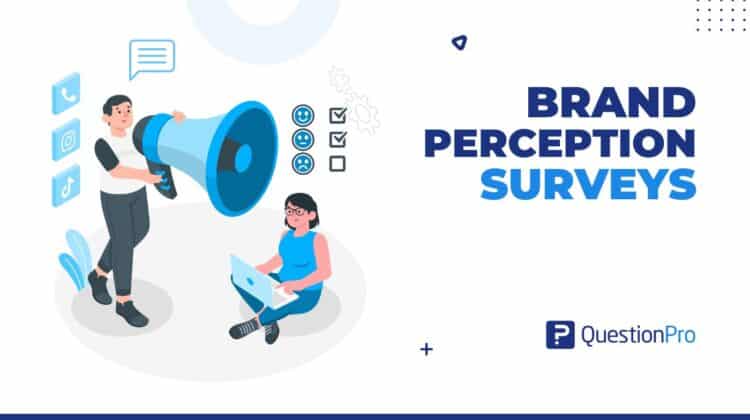
Understanding how customers view your brand is crucial for building a long-lasting relationship and a successful business. Brand perception surveys are structured sets of questions that capture how people perceive your brand. Businesses use these surveys to track brand image over time and identify changes that could improve customer perception.
But what exactly does a brand perception survey measure? And why is it so important for improving your brand’s image?
In this blog, we’ll explore brand perception surveys, how they work, and how they can help your brand not just survive, but thrive in a competitive market.
What Are Brand Perception Surveys?
A brand perception survey is a questionnaire businesses use to measure how consumers feel, think, and perceive their brand. Unlike traditional market research, these surveys focus on capturing emotional responses and associations, which are crucial for understanding customer loyalty, brand trust, and overall image.
By analyzing the responses, businesses can identify areas for improvement, create targeted marketing strategies, and enhance their overall brand positioning in the market.
Brand Perception, Brand Awareness, and Brand Equity are often confused, but each refers to a different concept in branding. Here’s how they differ:
- Brand Perception: How customers view and feel about your brand.
- Brand Awareness: The extent to which customers can recognize or recall your brand.
- Brand Equity: The value of your brand in the market, built from customer loyalty, perception, and trust.
Understanding these differences is essential for shaping your brand’s overall success.
Brand perception surveys are valuable tools at various points in a brand’s lifecycle. They are especially useful when:
- Launching a new product or service.
- Rebranding or making positioning changes to your brand.
- Tracking long-term brand health and consumer behavior over time.
- Evaluating marketing campaigns to assess if the intended message resonates with your audience.
Why Brand Perception Surveys Are Important for Improving Brand Image
Brand image is everything when it comes to consumer decision-making. How your customers perceive your brand directly influences their trust, loyalty, and, ultimately, their purchasing decisions. Brand perception surveys play a key role in shaping and improving this image by providing businesses with actionable insights straight from their audience.
These surveys go beyond surface-level feedback and help you understand how people emotionally connect with your brand. By gathering data on sentiment, values, and associations, companies can pinpoint where they’re succeeding and where they need to improve.
Here’s why brand perception surveys are crucial for brand image improvement:
- Identify Gaps Between Brand Intent and Perception
These surveys help you understand whether your messaging, products, and customer experiences align with your intended brand image.
- Measure Customer Trust and Loyalty
Assessing customer trust and satisfaction helps you identify areas that need attention, whether it’s product quality, customer service, or brand ethics.
- Track Brand Health Over Time
Regular surveys allow you to track shifts in perception and make informed decisions to keep your brand on track.
- Guide Strategic Decisions
Insights from brand surveys can inform everything from marketing strategies to product development.
Brand perception surveys offer a roadmap to improving brand image. They help align customer expectations with brand actions, foster stronger customer relationships, and boost long-term brand loyalty.
What Do Brand Perception Surveys Measure?
Brand perception surveys measure various elements and help businesses understand their market position and provide insights into how to improve customer experience, loyalty, and engagement. Below are the key areas brand perception surveys focus on:
Brand Visibility & Sentiment Measures
- Awareness: It’s a key indicator that measures how well consumers recognize or recall your brand.
- Associations: These are the feelings, perceptions, and images consumers connect with your brand. Positive associations can enhance your brand’s value, while negative associations can hurt it.
- Sentiment: Sentiment helps you measure whether customers feel positively, negatively, or neutrally about your brand.
Brand Credibility & Value Metrics
- Trust: Trust is how much consumers believe in your brand’s ability to deliver on its promises. A brand that builds trust with its customers can enjoy long-term loyalty and positive word of mouth.
- Quality: This measures how consumers perceive the quality of your products or services. High-quality perceptions often result in higher customer satisfaction and repeat purchases.
- Value: This is the relationship between the benefits a consumer receives and the price they pay. Measuring value perception helps ensure that customers feel they’re getting a fair deal.
Buyer Intent & Decision Indicators
- Consideration: This measures whether consumers are actively thinking about your brand when making purchasing decisions. It is a key precursor to conversion.
- Preference: This indicates how likely customers are to choose your brand over competitors.
- Purchase Intent: This measures the likelihood that consumers will purchase from your brand in the future. High purchase intent signals that your brand resonates well with your target audience, and is an excellent indicator of sales growth and customer retention.
Loyalty Indicators
- NPS (Net Promoter Score): It asks customers how likely they are to recommend your brand to others. A high NPS score suggests strong brand loyalty and positive customer experiences.
- CSAT (Customer Satisfaction Score): It provides immediate feedback that can help businesses understand how well they are meeting customer expectations on a day-to-day basis.
- eNPS (Employee Net Promoter Score): eNPS measures employee loyalty, which indirectly affects brand perception. Engaged and loyal employees are more likely to provide positive customer experiences, and their attitudes can impact how customers perceive the brand.
Question Types and Brand Perception Survey Template
When designing a brand perception survey, the type of questions you ask will significantly impact the quality and clarity of the insights you gather. Different types of questions help you measure various aspects of brand perception, such as awareness, sentiment, associations, and loyalty.
Below are the most common question types used in brand perception surveys, along with example templates that you can use directly in your own surveys.
Core Questions for Understanding Brand Perception
To capture the foundational elements of brand perception, you’ll need to ask questions that assess consumer awareness, the associations they have with your brand, and their emotional sentiment.
- Awareness Questions: These measure how well customers recognize or recall your brand. Typical questions might include:
- “When thinking of a smartphone, which brands come to mind first?”
- “Have you heard of the ABC phone before? Yes/No”
- Association Questions: These aim to uncover what specific attributes or emotions consumers associate with your brand. Example questions include:
- “What is the first word that comes to mind when you think of the ABC phone company?”
- “Which of the following characteristics best describes the ABC phone company? (Select all that apply: innovative, trustworthy, premium, affordable, etc.)”
- Sentiment Questions: To gauge the overall feeling customers have toward your brand, use questions that capture sentiment:
- “How do you feel about the ABC phone company on a scale from 1 to 10? (1 = Very Negative, 10 = Very Positive)”
- “Do you agree or disagree with the statement: ‘ABC phone company meets my expectations’?”
Measuring Attitudes and Opinions
These types of questions allow you to gather more nuanced responses and track the intensity of opinions.
- Likert Scales: Likert scale questions measure attitudes or opinions on a 5- or 7-point scale (Strongly Agree to Strongly Disagree). These are ideal for gauging sentiment and satisfaction levels.
- “How satisfied are you with ABC phone company on the following aspects?”
- Product Quality: (1 = Very Dissatisfied, 5 = Very Satisfied)
- Customer Service: (1 = Very Dissatisfied, 5 = Very Satisfied)
- “How satisfied are you with ABC phone company on the following aspects?”
- Semantic Differential Scales: These questions ask respondents to rate a brand along a bipolar scale (e.g., good vs. bad, modern vs. outdated).
- “How would you rate [brand name] on the following scale?”
- Quality: (Poor 1 | 2 | 3 | 4 | 5 Excellent)
- Innovation: (Not Innovative 1 | 2 | 3 | 4 | 5 Very Innovative)
- “How would you rate [brand name] on the following scale?”
- Open-Ended Questions: These provide respondents the opportunity to express their thoughts in their own words. Open-ended questions are particularly useful for uncovering deeper insights that might not be captured by predefined options.
- “What do you like most about the ABC phone company?”
- “What improvements would you suggest for the ABC phone company?”
Understanding Market Position and Emotional Connections
To understand your brand’s position in the market, it’s important to compare it to competitors and uncover the deeper emotional connections consumers have with your brand.
- Competitive Frame Questions: These questions compare your brand to competitors, helping you measure where you stand in the minds of consumers.
- “How does ABC phone company compare to XYZ phone company in terms of quality?”
- “Which brand would you prefer for a smartphone? (Choose one: ABC phone company, GHI phone company, LMN phone company, XYZ phone company”
- Brand Laddering Questions: These questions help uncover the deeper values and emotional drivers behind customer preferences.
- “Why do you choose ABC phone company over other brands? (Select all that apply)”
- “It offers better quality”
- “It aligns with my values.”
- “It provides better value for money”
- “What does ABC phone company mean to you beyond just a product or service?”
- “Why do you choose ABC phone company over other brands? (Select all that apply)”
Example of A Brand Perception Survey Template
Here’s a quick set of example questions that you can use directly in your brand perception surveys:
- Awareness: “Which of the following brands have you heard of before? (Check all that apply)”
- Associations: “What three words would you use to describe ABC phone company?”
- Sentiment: “How would you rate your overall satisfaction with ABC phone company on a scale from 1 to 10?”
- Trust: “How much do you trust ABC phone company to deliver high-quality products? (1 = Not at all, 5 = Completely)”
- Purchase Intent: “How likely are you to purchase from ABC phone company again in the future? (1 = Very Unlikely, 5 = Very Likely)”
How Brand Perception Surveys Help to Improve Brand Image: A Step-by-Step Guide
Improving your brand image is an ongoing process, and brand perception surveys are an essential tool to help guide you. Follow these steps to improve your brand image using brand perception surveys:

Step 1: Identify Strengths and Weaknesses
Start by analyzing the responses to identify what your brand is doing well and where it’s falling short.
For example, if customers praise your customer service but express concerns about product quality, you know where to focus your efforts.
Step 2: Align with Changing Consumer Expectations
Customer preferences and expectations can change over time. If you discover that your brand is no longer seen as innovative or if customers are seeking more affordable options, you can adjust your offerings to meet those needs.
Step 3: Refine Your Messaging
If the survey results show that your audience doesn’t fully understand what your brand stands for, it’s time to refine your messaging.
- Clarify your brand’s value proposition
- Adjust the tone and language to better resonate with your audience
- Ensure consistency across all communication channels
Step 4: Track Progress Over Time
Conducting regular surveys allows you to track changes in consumer sentiment and measure the success of any changes you’ve implemented.
For example, if you’ve improved your product quality or customer service, you can see if those efforts are being reflected in improved brand perception. Tracking progress helps ensure you’re consistently improving your brand image.
Step 5: Build Trust and Loyalty
If your survey results highlight a gap in customer trust, take action to address it. This could involve:
- Improving product reliability
- Increasing transparency
- Addressing any concerns customers have
As trust grows, so does customer loyalty, which is key to maintaining a strong brand image.
Step 6: Strengthen Customer Relationships
Finally, use the feedback you receive to engage with your customers more meaningfully. When customers see that their opinions matter and that you are actively working to address their concerns, they are more likely to develop a stronger emotional connection with your brand.
How QuestionPro CX Helps to Improve Brand Image
QuestionPro CX is a powerful tool that helps businesses improve their brand image by providing deep insights into customer perception and feedback. With its advanced features and user-friendly interface, QuestionPro CX allows you to gather actionable data and make informed decisions that directly enhance your brand’s image. Here’s how QuestionPro CX can help:
Features for Questionnaire Design
A well-designed survey is crucial for obtaining accurate and meaningful data. QuestionPro CX provides several must-have features to ensure your brand perception surveys are effective:
- QuestionPro AI
Question AI uses machine learning to generate smart, relevant survey questions based on your survey objectives, ensuring you capture the right data every time.
- Customizable Question Types
You can choose from a variety of question formats, including Likert scales, NPS, CSAT, CES, semantic differentials, and open-ended questions, to customize your survey to gather specific insights.
- Survey Flow and Logic
Advanced logic guides respondents based on their previous answers. It ensures you capture the most relevant data without overwhelming your audience.
- Multilingual Support
If you’re surveying a global audience, QuestionPro CX makes it easy to create surveys in multiple languages, ensuring you capture feedback from diverse markets.
- AI Sentiment Analysis
Sentiment Analysis enhances your survey data by analyzing open-ended responses and determining the sentiment behind them. Whether your customers provide positive, negative, or neutral feedback, it automatically categorizes and analyzes their sentiment in real time.
These features ensure that your surveys are engaging, easy to complete, and designed to gather the most valuable insights into how customers perceive your brand.
Additionally, QuestionPro’s Survey Template Library provides a wide range of pre-built, customizable survey templates. These templates cover various aspects of brand perception, including customer satisfaction, NPS, and market research. You can easily select a template that suits your needs, personalize it with your branding, and start gathering data quickly.
Dashboards for Real-Time Insights
QuestionPro CX offers powerful dashboards that help you visualize your data in a clear and actionable way. These dashboards allow you to:
- Track Brand Health
- Filter and Segment Data
- Visualize Survey Data
- Provide Actionable Insights
Integrations for BI and Marketing Systems
QuestionPro CX seamlessly integrates with leading business intelligence (BI) and marketing systems, making it easier to connect customer perception data with other business tools. These integrations allow you to:
- Connect survey data to your CRM.
- Integrate with BI platforms like Tableau or Power BI to conduct more advanced analysis.
By combining real-time insights, customizable survey features, and powerful integrations, QuestionPro CX provides everything you need to improve your brand image and foster stronger customer relationships.
Conclusion
Understanding how your customers perceive your brand is important to maintaining a strong, positive image. Brand perception surveys offer invaluable insights into customer sentiment, trust, loyalty, and overall brand health.
Businesses can gain deeper insights with QuestionPro CX, sentiment analysis, customizable templates, AI features, and powerful integrations to understand their brand’s position and take meaningful steps to improve it.
Whether you’re refining your messaging or adjusting your strategy based on customer feedback, QuestionPro CX equips you with the tools you need to foster stronger customer relationships, build trust, and enhance your brand image over time.
Start using QuestionPro CX today to gather actionable insights, track your brand’s perception, and make data-driven decisions that help you stay ahead of the competition.
Frequently Asked Questions (FAQs)
Answer: For most companies, conducting a survey once or twice a year is ideal to track overall brand health. However, if you’re in the middle of a rebranding effort, launching a new product, or running a significant marketing campaign, more frequent surveys (e.g., quarterly) can provide immediate feedback.
Answer: For statistically significant results, aim for at least 300-500 responses. However, if you’re focusing on a smaller, more targeted segment, like loyal customers or a specific demographic, fewer responses may be sufficient.
Answer: A Net Promoter Score (NPS) of 50 or above is considered excellent, while a score below 0 suggests that your brand has work to do.
Answer: Absolutely! Small brands can run highly effective brand perception studies. By leveraging affordable survey platforms like QuestionPro CX, small businesses can access the same powerful tools used by larger companies without the hefty price tag.







